Bambang, Nueva Vizcaya
Bambang, officially the Municipality of Bambang (Gaddang: Ili na Bambang; Ilocano: Ili ti Bambang; Tagalog: Bayan ng Bambang), is a 1st class municipality in the province of Nueva Vizcaya, Philippines. According to the 2015 census, it has a population of 53,433 people. [3]
Bambang | |
|---|---|
| Municipality of Bambang | |
 Aerial view of Bambang | |
 Seal | |
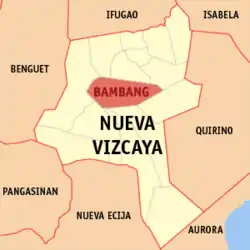 Map of Nueva Vizcaya with Bambang highlighted | |
OpenStreetMap 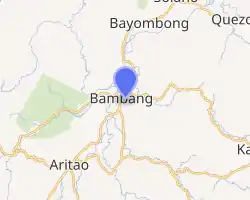
| |
.svg.png.webp) Bambang Location within the Philippines | |
| Coordinates: 16°22′57″N 121°06′36″E | |
| Country | |
| Region | Cagayan Valley (Region II) |
| Province | Nueva Vizcaya |
| District | Lone district |
| Barangays | 25 (see Barangays) |
| Government | |
| • Type | Sangguniang Bayan |
| • Mayor | Dr. Pepito D. Balgos |
| • Vice Mayor | Gregorio B. Allas Jr. |
| • Electorate | 32,599 voters (2019) |
| Area | |
| • Total | 345.00 km2 (133.21 sq mi) |
| Elevation | 392 m (1,286 ft) |
| Population | |
| • Total | 53,433 |
| • Density | 150/km2 (400/sq mi) |
| • Households | 13,272 |
| Economy | |
| • Income class | 1st municipal income class |
| • Poverty incidence | 8.41% (2015)[4] |
| • Revenue | ₱169,932,800.53 (2016) |
| Time zone | UTC+8 (PST) |
| ZIP code | 3702 |
| PSGC | |
| IDD : area code | +63 (0)78 |
| Climate type | tropical rainforest climate |
| Native languages | Gaddang Ilocano Isinai Tagalog |
The municipality is known for its salt springs at the Salinas Natural Monument.
History
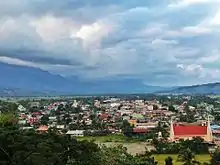
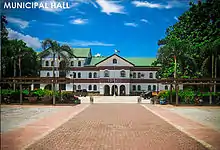
Bambang has its beginning in the early period of Spanish colonization. The name "Bambang" is an Isinay word meaning "to dig".
The first mission that dared to penetrate the dangerous wilderness and insect-infested jungles of what is southern Nueva Vizcaya today was by the Dominican Order in 1607. However, it was only two years later (1609) when a Dominican missionary come from Pangasinan. Father Tomas Gutierez arrived to establish the first missionary settlement. This settlement was subsequently called Ytuy which today actually comprises the towns of Aritao, Dupax, Bambang and a part of the Igorot tribal lands to the west (now Kayapa). Originally these places were inhabited by the Igorot and Panuypuyes (Aritao), the Ilongots (Dupax and Bambang) and the lgorot in the area west from the present native population of Dupax, Aritao, and Bambang came about by the inter-marriages of the tribes mentioned above.
Recent development and progress
In 2012, Bambang became open to big dealers and businessmen as part of its progress. Now the town has its own newly opened fast food chains and other marketing establishments.[5]
Demographics
|
| ||||||||||||||||||||||||||||||||||||||||||||||||
| Source: Philippine Statistics Authority [3] [6] [7][8] | |||||||||||||||||||||||||||||||||||||||||||||||||
Local government
As per Philippine Statistics Authority, Nueva Vizcaya province is part of Region-II (Cagayan Valley), Province Code for Nueva Vizcaya is 50, Municipality Code for Bambang Municipality within Nueva Vizcaya province is 4.
Province of Nueva Vizcaya is administered or governed by a governor. Bambang Municipality is administered or governed by a mayor. Each Barangay is administered or governed by a Punong Barangay (Barangay Captain in English).
Barangays
Bambang is politically subdivided into 25 barangays.
- Abian
- Abinganan
- Aliaga
- Almaguer North
- Almaguer South
- Banggot (Urban)
- Barat
- Buag (Urban)
- Calaocan (Urban)
- Dullao
- Homestead (Urban)
- Indiana
- Mabuslo
- Macate
- Magsaysay Hill (Urban)
- Manamtam
- Mauan
- Pallas
- Salinas
- San Antonio North
- San Antonio South
- San Fernando
- San Leonardo
- Santo Domingo Proper (Tabangan)
- Santo Domingo West
List of former mayors
- Luisa Lloren Cuaresma: 1989–1998
- Dr. Pepito D. Balgos M.d.: 1998–2007
- Benjamin L.Cuaresma III: 2007–2010
- Atty. Flaviano D. Balgos, Jr.: 2010–2019
Transportation
Among the most popular form of travel in and around Bambang is by jeepney. Jeepnies are used to bring produce in from neighboring municipalities, and for public transportation for residents and travelers. For shorter distances, tricycles are another great form of public transportation.
Bambang is less than a day away from the beautiful Banaue Rice Terraces and hour away from shopping in the urban Solano.
Celebrations
Pangayjaya is the festival name of the town which celebrated in late May to April yearly. Part of it is the annual Miss Pangayjaya (Bambang) and the counterpart Mister Bambang started in 2016. Along with celebration of its patron, Saint Catherine of Siena.
Education
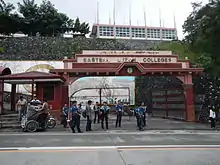
Tertiary:
- King's College of the Philippines (formerly: Eastern Luzon Colleges)
- Nueva Vizcaya State University
- Advocates College
High School:
- King's College of the Philippines (formerly: Eastern Luzon Colleges)
- Saint Catherine's School
- Nueva Vizcaya State University(Laboratory School)
- Bambang National High School
- Salinas High School
- Kiddie Kingdom International School
Elementary/Middle School:
- Aurora Christian School Foundation
- Abinganan Elementary School
- Bambang West Elementary School
- Bambang Central School
- Bambang North Central School
- Bambang East Elementary School
- Barat Elementary School
- Almaguer North Elementary School
- Almaguer South Elementary School
- Kiddie Kingdom International School
- Saint Catherine's School
- San Antonio South Elementary School
- San Antonio North Elementary School
- Camella SNV Montessori School
- Indiana Elementary School
- Mauan Elementary School
- Mabuslo Elementary School
- Salinas Elementary School
- San Fernando Elementary School
- San Leonardo Elementary School
Images
 Bambang Municipal Hall
Bambang Municipal Hall Saint Catherine of Siena Parish Church
Saint Catherine of Siena Parish Church Bambang Gymnasium
Bambang Gymnasium Bambang (agriculture) Monument
Bambang (agriculture) Monument Welcome Lion Monument
Welcome Lion Monument
References
- Municipality of Bambang | (DILG)
- "Province: Nueva Vizcaya". PSGC Interactive. Quezon City, Philippines: Philippine Statistics Authority. Retrieved 12 November 2016.
- Census of Population (2015). "Region II (Cagayan Valley)". Total Population by Province, City, Municipality and Barangay. PSA. Retrieved 20 June 2016.
- "PSA releases the 2015 Municipal and City Level Poverty Estimates". Quezon City, Philippines. Retrieved 1 January 2020.
- "Archived copy". Manila Bulletin. Archived from the original on 13 May 2012. Retrieved 16 June 2012.CS1 maint: archived copy as title (link) |title: Bambang, Nueva Vizcaya Development
- Census of Population and Housing (2010). "Region II (Cagayan Valley)". Total Population by Province, City, Municipality and Barangay. NSO. Retrieved 29 June 2016.
- Censuses of Population (1903–2007). "Region II (Cagayan Valley)". Table 1. Population Enumerated in Various Censuses by Province/Highly Urbanized City: 1903 to 2007. NSO.
- "Province of Nueva Vizcaya". Municipality Population Data. Local Water Utilities Administration Research Division. Retrieved 17 December 2016.
External links
| Wikimedia Commons has media related to Bambang, Nueva Vizcaya. |
